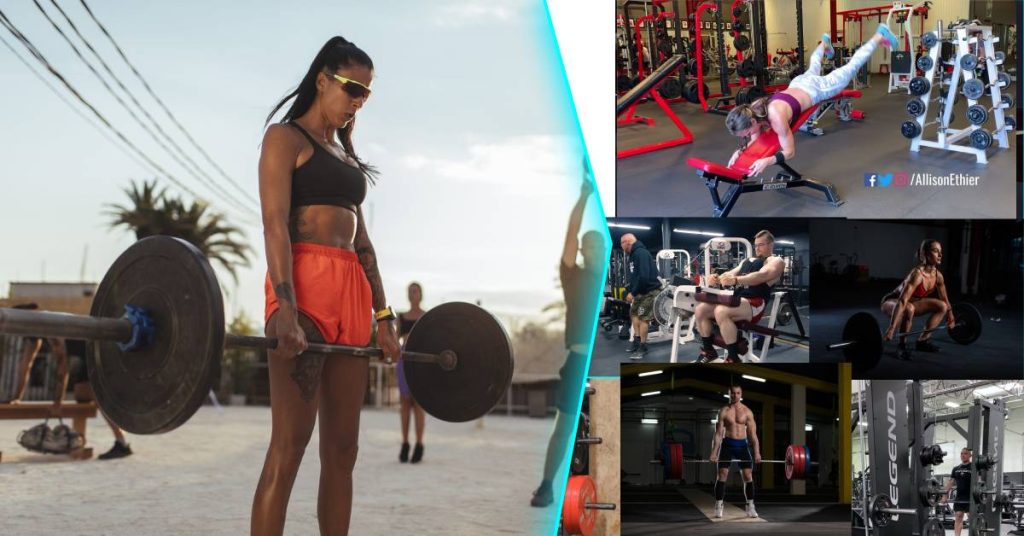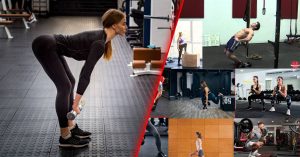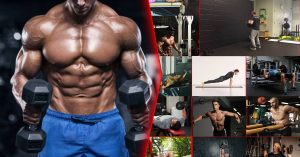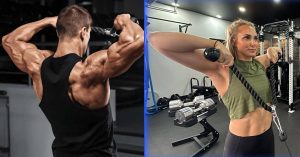You may be searching over the internet what are the Best lower body pull exercises to improve your strength in the lower body and overall fitness. If that’s the case, you don’t need to look further elsewhere. It’s because we have covered all available best exercise options that can help you achieve your goal with this article.
Let’s get started…
Table of Contents
MORE keyboard_double_arrow_down LESS keyboard_double_arrow_up
What are Lower Body Pull Exercises?
Lower body pull exercises constitute a category of strength-training movements focused on engaging the muscles of the posterior chain, including the hamstrings, glutes, and lower back.
In these exercises, the primary action involves pulling resistance towards the body or lifting weight away from the ground using the lower body muscles.
Here are the key characteristics of lower body pull exercises:
- Muscle Targeting: Lower body pull exercises primarily target the posterior chain muscles, including the hamstrings, glutes, and lower back. These muscles are crucial for activities such as bending, lifting, and maintaining proper posture.
- Pulling Motion: Unlike lower body push exercises, where the legs are extending or pushing against resistance, lower body pull exercises involve movements where the legs pull weight or resistance towards the body or lift it away from the ground.
- Exercise Varieties: Lower body pull exercises come in various forms, including deadlift variations like conventional deadlifts and Romanian deadlifts, as well as other movements such as kettlebell swings, cable pull-throughs, and good mornings.
- Functional Benefits: Just like lower body push exercises, lower body pull exercises offer functional benefits by improving strength, power, and mobility in movements essential for daily activities and sports performance.
- Compound Movements: Many lower body pull exercises are compound movements, meaning they engage multiple muscle groups and joints simultaneously. This results in more efficient workouts and better overall muscle development.
Incorporating lower body pull exercises into your fitness routine can help build strength, power, and muscular balance in the lower body while reducing the risk of injury and improving overall athletic performance.
Keep in mind, it’s essential to perform these exercises with proper form and technique to maximize their effectiveness and minimize the risk of injury.
What are the benefits of including Lower Body Pull Exercises in your daily workout?
Including lower body pull exercises in your daily workout routine brings many benefits to your overall fitness. As we discussed before, these exercises focus on muscles like the hamstrings, glutes, and lower back, helping to build strength, improve mobility, and reduce the risk of injury.
By incorporating lower body pull exercises, you can enhance your lower body strength, stability, and functional movement, leading to improved performance in daily activities and sports.
In summary, here’s a list of benefits that you can gain by including lower body pull exercises into your daily workout:
- Strengthens the Posterior Chain: Lower body pull exercises target muscles such as the hamstrings, glutes, and lower back, collectively known as the posterior chain. Strengthening these muscles helps improve posture, stability, and overall lower body strength.
- Builds Muscle Mass: Lower body pull exercises are typically compound movements that engage multiple muscle groups simultaneously. This makes them highly effective for building muscle mass and improving muscle definition in the lower body.
- Enhances Athletic Performance: Strong posterior chain muscles are essential for various athletic movements, including running, jumping, and lifting. By improving strength and power in these muscles through lower body pull exercises, you can enhance your athletic performance and agility.
- Improves Functional Movement Patterns: Many lower body pull exercises mimic everyday movements like bending, lifting, and pulling. By incorporating these exercises into your daily workout routine, you can improve your ability to perform functional movements with ease and reduce the risk of injury during daily activities.
- Increases Metabolic Rate: Since lower body pull exercises often involve large muscle groups and compound movements, they can help increase your metabolic rate both during and after exercise. This can contribute to greater calorie burn and improved fat loss over time.
- Enhances Joint Health and Flexibility: Lower body pull exercises promote mobility and flexibility in the hips, knees, and ankles. Over time, this can lead to improved joint health, reduced risk of injury, and increased range of motion in lower body movements.
- Offers Variety and Balance: Including a variety of lower body pull exercises in your daily workout routine ensures that you target all the major muscles in the lower body while maintaining balance between pushing and pulling movements. This helps prevent muscle imbalances and promotes overall muscular symmetry.
Ok, now you may be wondering what are the Best Lower body pull exercises that can be included into your workout routine. No need to worry. Here are our top 17 picks for you.
What are the Best 17 Lower Body Pull Exercises?
1. Deadlift (Barbell)
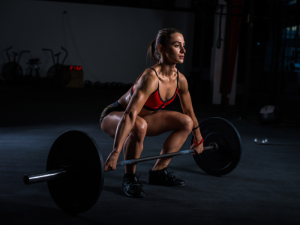
Deadlifts are a fundamental compound exercise that primarily targets the posterior chain, including the lower back, glutes, and hamstrings(source). It also engages the core and upper body muscles for stability and strength.
How To Do Deadlifts?
- Start by standing with your feet shoulder-width apart, toes pointing forward, and the barbell on the floor in front of you.
- Bend at your hips and knees, keeping your back straight and chest up, to grip the bar with an overhand grip slightly wider than shoulder-width apart.
- Engage your core and drive through your heels as you lift the barbell by extending your hips and knees simultaneously.
- Keep the barbell close to your body throughout the movement.
- Once you’re standing tall with your hips fully extended, reverse the motion by hinging at your hips and lowering the barbell back to the floor with control.
Execution Tips Enhanced:
- Ensure your back maintains a neutral spine throughout the movement to prevent injury.
- Keep your shoulders pulled back and down to maintain proper posture.
- Focus on pushing through your heels to engage the posterior chain effectively.
- Avoid rounding your back or hyperextending your spine.
Why It Works Explained:
Deadlifts target multiple muscle groups simultaneously, making them an efficient exercise for building overall strength and muscle mass. The hip hinge movement pattern mimics real-life activities and enhances functional strength.
Additionally, the load placed on the spine stimulates bone density, promoting bone health.
2. Sumo Deadlifts
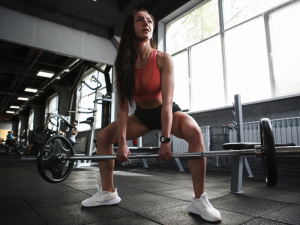
Sumo deadlifts are a variation of the conventional deadlift that emphasizes the inner thigh muscles (adductors) and places less stress on the lower back compared to the conventional stance. It’s particularly beneficial for individuals with longer limbs or limited hip mobility.
How To Do Sumo Deadlifts?
- Stand with your feet wider than shoulder-width apart and your toes pointed slightly outward.
- Position the barbell on the floor in front of you, closer to your body than in a conventional deadlift setup.
- Grip the barbell with your hands inside your legs using an overhand or mixed grip.
- Engage your core and drive through your heels to lift the barbell, extending your hips and knees simultaneously.
- Keep your back straight and chest up throughout the movement.
- Once standing tall with hips fully extended, reverse the motion by hinging at your hips and lowering the barbell back to the floor.
Execution Tips Enhanced:
- Maintain a wide stance with your knees tracking in line with your toes.
- Keep your torso upright to maximize engagement of the adductor muscles.
- Focus on driving your knees outwards during the lift to engage the hips and maintain stability.
- Avoid allowing your knees to collapse inward.
Why It Works Explained:
Sumo deadlifts target the inner thigh muscles more directly due to the wider stance, providing greater activation of the adductors. This variation also reduces the range of motion required by the lower back, making it a suitable option for individuals with lower back issues or limited mobility.
Additionally, sumo deadlifts help improve hip mobility and flexibility.
3. Romanian Deadlifts
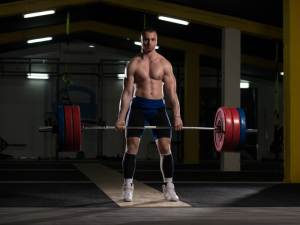
Romanian deadlifts primarily target the posterior chain, including the hamstrings, glutes, and lower back. This exercise emphasizes hip hinge movement, helping to strengthen the muscles involved in hip extension while minimizing stress on the lower back.
How To Do Romanian Deadlifts?
- Begin by standing with your feet hip-width apart and holding a barbell or dumbbells in front of your thighs with an overhand grip.
- Engage your core and retract your shoulder blades to maintain a neutral spine throughout the movement.
- Hinge at your hips, keeping your knees slightly bent but stationary, and lower the weight by pushing your hips back.
- Lower the weight until you feel a stretch in your hamstrings or until your torso is parallel to the floor, ensuring the barbell stays close to your body.
- Pause briefly at the bottom of the movement, then reverse the motion by driving through your heels and extending your hips to return to the starting position.
Execution Tips Enhanced:
- Keep a slight bend in your knees throughout the exercise to protect the joints and maintain tension in the hamstrings.
- Focus on maintaining a straight back and avoiding rounding or arching your spine.
- Control the descent of the weight to fully engage the hamstrings and prevent momentum.
- Squeeze your glutes at the top of the movement to fully engage the hip extensors.
Why It Works Explained:
Romanian deadlifts are effective for developing strength and muscle hypertrophy in the hamstrings and glutes while placing less stress on the lower back compared to conventional deadlifts. By emphasizing the hip hinge movement pattern, this exercise improves hip mobility and strengthens the posterior chain, which is essential for various functional movements and athletic performance.
4. Single-Leg Romanian Deadlifts
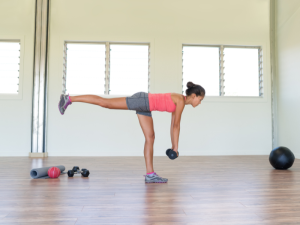
Single-leg Romanian deadlifts are a unilateral exercise that targets the posterior chain, focusing on balance, stability, and strength development. This exercise helps address muscle imbalances between the left and right sides of the body while also improving core stability.
How To Do Single-Leg Romanian Deadlifts?
- Begin by standing tall with your feet hip-width apart and holding a dumbbell or kettlebell in one hand.
- Shift your weight onto one leg while keeping a slight bend in the knee of the supporting leg.
- Hinge at your hips and lower the weight towards the ground, extending your non-supporting leg straight back behind you for balance.
- Keep your back flat and chest lifted throughout the movement, maintaining a neutral spine.
- Lower the weight until you feel a stretch in your hamstrings or until your torso is parallel to the floor.
- Pause briefly at the bottom of the movement, then drive through the heel of the supporting leg to return to the starting position.
Execution Tips Enhanced:
- Maintain a slight bend in the knee of the supporting leg to prevent hyperextension and provide stability.
- Keep your hips square and facing forward throughout the movement to avoid rotation.
- Engage your core muscles to stabilize your torso and maintain balance.
- Focus on controlling the descent and ascent of the weight to maximize muscle activation.
Why It Works Explained:
Single-leg Romanian deadlifts help improve balance, coordination, and proprioception while targeting the hamstrings, glutes, and lower back. By isolating each leg independently, this exercise highlights and addresses any strength or stability discrepancies between the left and right sides of the body.
Additionally, the unilateral nature of the movement enhances functional strength and athleticism, translating to better performance in sports and daily activities.
5. Good Mornings
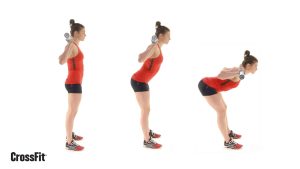
Good mornings are a compound exercise that primarily targets the posterior chain, including the lower back, glutes, and hamstrings. This exercise also engages the core muscles for stability and strength.
How To Do Good Mornings?
- Begin by standing with your feet shoulder-width apart and a barbell resting across your upper back, behind your neck.
- Engage your core and retract your shoulder blades to maintain a neutral spine throughout the movement.
- Keeping your knees slightly bent, hinge at your hips and lean forward, lowering your torso towards the floor.
- Lower your torso until you feel a stretch in your hamstrings or until your torso is parallel to the floor, maintaining a straight back.
- Pause briefly at the bottom of the movement, then reverse the motion by driving through your heels and extending your hips to return to the starting position.
Execution Tips Enhanced:
- Keep your back flat throughout the movement, avoiding rounding or arching of the spine.
- Focus on pushing your hips back as you lower your torso, emphasizing the stretch in the hamstrings.
- Control the descent and ascent of the weight to fully engage the posterior chain muscles.
- Use a lighter weight than you would for squats or deadlifts to ensure proper form and reduce the risk of injury.
Why It Works Explained:
Good mornings target the posterior chain muscles, including the hamstrings, glutes, and lower back, making them an effective exercise for improving strength and muscle hypertrophy in these areas. By emphasizing the hip hinge movement pattern, this exercise also helps improve hip mobility and flexibility while reducing stress on the lower back.
Additionally, good mornings engage the core muscles for stability and balance, contributing to overall functional strength and athleticism.
6. Glute Ham Raise
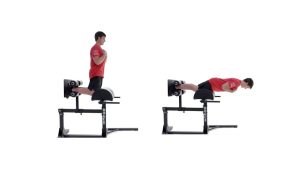
The glute ham raise is an advanced exercise that primarily targets the hamstrings and glutes while also engaging the lower back and calves. It’s an excellent option for strengthening the posterior chain and improving athletic performance.
How To Do Glute Ham Raises?
- Begin by kneeling on a glute-ham raise machine with your knees positioned at the padded platform and your feet secured under the foot pads.
- Engage your core and lower your torso towards the floor by bending at the knees, maintaining a straight line from your knees to your shoulders.
- Keep your hips extended and gradually lower your torso as far as possible while maintaining control.
- Reverse the movement by contracting your hamstrings and glutes to lift your torso back up to the starting position until your body forms a straight line.
Execution Tips Enhanced:
- Keep your back straight throughout the movement to avoid excessive strain on the lower back.
- Control the descent and ascent of your body to fully engage the hamstrings and glutes.
- Engage your core muscles to stabilize your body throughout the exercise.
- Adjust the resistance on the machine according to your strength level, starting with lighter resistance if you’re new to the exercise.
Why It Works Explained:
The glute ham raise targets the hamstrings and glutes dynamically, promoting strength and hypertrophy in these muscle groups. By isolating the posterior chain, this exercise helps correct muscle imbalances and enhances athletic performance, particularly in activities that require explosive lower body strength.
Additionally, the glute ham raise strengthens the lower back and improves core stability, contributing to overall strength and injury prevention.
7. Reverse Hyperextensions
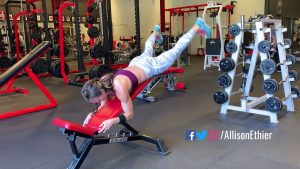
Reverse hyperextensions are an effective exercise for targeting the hamstrings, glutes, and lower back while also improving spinal erector strength and stability. This exercise is commonly used in strength training and rehabilitation programs to strengthen the posterior chain.
How To Do Reverse Hyperextensions?
- Lie face down on a hyperextension bench with your hips positioned at the edge and your legs extended straight behind you.
- Grasp the handles or the sides of the bench for stability.
- Engage your core and glutes as you lift your legs upward until they are in line with your torso, forming a straight line.
- Squeeze your glutes at the top of the movement and hold for a brief moment.
- Lower your legs back down under control until they are parallel to the floor or slightly below, maintaining tension in the hamstrings and glutes.
Execution Tips Enhanced:
- Keep your movements controlled throughout the exercise to prevent swinging or momentum.
- Focus on contracting the glutes and hamstrings to lift the legs, avoiding excessive arching of the lower back.
- Maintain a neutral spine throughout the movement, avoiding hyperextension or rounding of the back.
- Adjust the range of motion based on your flexibility and comfort level, avoiding any discomfort or strain.
Why It Works Explained:
Reverse hyperextensions target the posterior chain muscles, including the hamstrings, glutes, and lower back, effectively strengthening and stabilizing these muscle groups. By isolating the posterior chain, this exercise helps improve hip extension strength and power, which is essential for various athletic movements and activities.
Additionally, reverse hyperextensions can help alleviate lower back pain and improve spinal erector endurance, making them beneficial for both strength training and rehabilitation purposes.
8. Cable Pull-Throughs
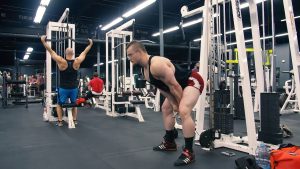
Cable pull-throughs are a compound exercise that targets the posterior chain, including the hamstrings, glutes, and lower back. This exercise is particularly effective for developing hip hinge mechanics and improving strength and power in the hip extensors.
How To Do Cable Pull-Throughs?
- Begin by setting up a cable machine with a low pulley attachment and attaching a rope or handle to the cable.
- Stand facing away from the cable machine with your feet shoulder-width apart and the cable between your legs.
- Grab the rope or handle with both hands and step forward a few feet to create tension in the cable.
- Hinge at your hips and lower your torso towards the ground while keeping your back flat and chest up.
- Push your hips back as far as possible while maintaining a slight bend in your knees.
- Drive through your heels and extend your hips to bring your torso back to the upright position, squeezing your glutes at the top of the movement.
- Repeat for the desired number of repetitions.
Execution Tips Enhanced:
- Keep your core engaged and back flat throughout the movement to maintain proper form and prevent lower back strain.
- Focus on driving your hips back and feeling a stretch in your hamstrings at the bottom of the movement.
- Control the speed of the movement, emphasizing the eccentric (lowering) phase to fully engage the posterior chain.
- Keep tension in the cable throughout the exercise, avoiding slack in the rope or handle.
Why It Works Explained:
Cable pull-throughs are effective for targeting the posterior chain muscles, including the hamstrings, glutes, and lower back, while also improving hip hinge mechanics and hip extension strength. By using a cable machine, this exercise provides constant tension throughout the movement, maximizing muscle engagement and promoting muscle growth and strength development.
Additionally, cable pull-throughs offer a safer alternative to traditional barbell exercises like deadlifts, as they reduce the risk of lower back injury while still effectively targeting the same muscle groups.
9. Nordic Hamstring Curls
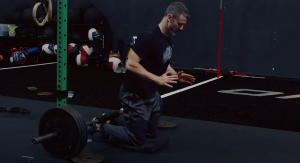
Nordic hamstring curls are an advanced bodyweight exercise that specifically targets the hamstrings, particularly the eccentric phase of the movement. This exercise is excellent for developing hamstring strength, reducing the risk of hamstring injuries, and improving athletic performance.
How To Do Nordic Hamstring Curls?
- Begin by kneeling on a soft surface with your feet anchored under a sturdy object or with a partner holding your ankles.
- Engage your core and glutes to maintain a straight line from your knees to your shoulders.
- Slowly lower your torso towards the ground by bending at the knees, controlling the descent with your hamstrings.
- Lower your body as far as possible while maintaining control and keeping your hips extended.
- Push through your heels and use your hamstrings to return to the starting position, lifting your torso back up to the kneeling position.
Execution Tips Enhanced:
- Keep your movements slow and controlled throughout the exercise, especially during the eccentric (lowering) phase.
- Focus on engaging the hamstrings to control the descent, avoiding any sudden drops or jerky movements.
- Maintain tension in the hamstrings throughout the movement, even at the bottom position.
- Use a padded surface for comfort and to protect your knees during the exercise.
Why It Works Explained:
Nordic hamstring curls target the hamstrings, particularly during the eccentric phase of the movement, which helps strengthen the muscle and improve its ability to withstand high forces and rapid lengthening. This exercise is highly effective for reducing the risk of hamstring injuries, such as strains or tears, by improving hamstring strength and resilience.
Additionally, Nordic hamstring curls improve athletic performance by enhancing sprinting speed, jumping ability, and overall lower body strength.
10. Straight Leg Deadlift
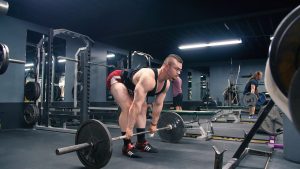
Straight leg deadlifts, also known as stiff-leg deadlifts, are a variation of the conventional deadlift that specifically targets the hamstrings and lower back while also engaging the glutes and core. This exercise emphasizes the stretch and eccentric loading of the hamstrings.
How To Do Straight Leg Deadlifts:
- Begin by standing with your feet hip-width apart and holding a barbell, dumbbells, or kettlebells in front of your thighs with an overhand grip.
- Engage your core and retract your shoulder blades to maintain a neutral spine throughout the movement.
- Keeping a slight bend in your knees, hinge at your hips and lean forward, lowering the weight towards the floor.
- Lower the weight until you feel a stretch in your hamstrings or until your torso is parallel to the floor, maintaining a straight back.
- Keep the movement controlled and avoid rounding your back.
- Pause briefly at the bottom of the movement, then reverse the motion by driving through your heels and extending your hips to return to the starting position.
Execution Tips Enhanced:
- Keep your back flat throughout the movement, avoiding rounding or arching of the spine.
- Focus on pushing your hips back as you lower the weight, emphasizing the stretch in the hamstrings.
- Control the descent and ascent of the weight to fully engage the posterior chain muscles.
- Use lighter weights than you would for conventional deadlifts to ensure proper form and reduce the risk of injury.
Why It Works Explained:
Straight leg deadlifts target the hamstrings, lower back, and glutes, making them an effective exercise for developing strength and muscle hypertrophy in these areas. By emphasizing the eccentric phase of the movement and the stretch on the hamstrings, this exercise helps improve flexibility and mobility while also strengthening the muscles involved in hip extension.
Additionally, straight leg deadlifts can help address muscle imbalances and asymmetries between the left and right sides of the body, leading to improved overall lower body strength and function.
11. Rack Pull
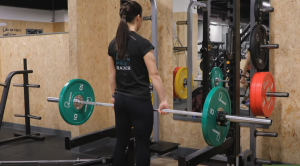
Rack pulls are a variation of the deadlift that focuses on partial range of motion, primarily targeting the upper back, traps, and spinal erectors. This exercise is beneficial for developing strength and muscle mass in the upper body while also improving grip strength.
How To Do Rack Pulls?
- Set up a barbell on a power rack or squat rack at knee height or slightly above.
- Stand with your feet shoulder-width apart and position yourself in front of the barbell.
- Grip the barbell with an overhand or mixed grip, slightly wider than shoulder-width apart.
- Engage your core and retract your shoulder blades to maintain a neutral spine throughout the movement.
- Drive through your heels and extend your hips and knees to lift the barbell off the rack.
- Keep your back straight and chest up as you lift the barbell, pulling your shoulders back at the top of the movement.
- Lower the barbell back down to the rack under control, maintaining tension in the upper back and traps.
Execution Tips Enhanced:
- Focus on driving through your heels and engaging your glutes and hamstrings to lift the weight.
- Keep your shoulders pulled back and down to maintain proper posture and minimize stress on the shoulders.
- Control the descent of the weight to fully engage the muscles and avoid bouncing the barbell off the rack.
- Use a weight that allows you to maintain proper form and control throughout the movement.
Why It Works Explained:
Rack pulls target the upper back, traps, and spinal erectors, helping to develop strength and muscle mass in these areas. By focusing on partial range of motion, rack pulls allow you to lift heavier weights than traditional deadlifts, making them effective for building overall upper body strength and muscle hypertrophy.
Additionally, rack pulls can help improve grip strength and forearm development, as the grip is challenged when lifting heavy weights for multiple repetitions.
12. Glute Bridge

The glute bridge is a foundational exercise that primarily targets the glutes while also engaging the hamstrings and lower back. It’s a simple yet effective movement that can help improve hip strength, stability, and overall lower body function.
How To Do Glute Bridges?
- Begin by lying on your back with your knees bent and feet flat on the ground, hip-width apart.
- Engage your core and press your lower back into the floor to stabilize your spine.
- Push through your heels and squeeze your glutes to lift your hips towards the ceiling until your body forms a straight line from your knees to your shoulders.
- Hold the top position for a brief moment, focusing on contracting the glutes.
- Slowly lower your hips back down to the starting position with control, maintaining tension in the glutes throughout the movement.
Execution Tips Enhanced:
- Keep your feet flat on the ground and your knees in line with your toes throughout the exercise.
- Avoid arching your lower back or hyperextending your spine at the top of the movement.
- Focus on fully contracting the glutes at the top of the bridge to maximize muscle activation.
- Use a controlled tempo, emphasizing both the upward and downward phases of the movement.
Why It Works Explained:
Glute bridges target the glutes, which are essential for various lower body movements, including walking, running, and squatting. By strengthening the glutes, this exercise can help improve overall lower body function and performance while also reducing the risk of injuries, such as low back pain and knee injuries.
Additionally, glute bridges can be easily modified to increase or decrease the intensity, making them suitable for individuals of all fitness levels. Incorporating glute bridges into your routine can also help improve posture and alleviate tightness in the hips and lower back, leading to improved mobility and flexibility.
13. Landmine Romanian Deadlift
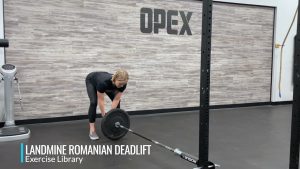
The Landmine Romanian Deadlift (RDL) is a variation of the traditional Romanian deadlift performed with a landmine attachment. This exercise primarily targets the hamstrings, glutes, and lower back while also engaging the core and upper body for stability.
How To Do Landmine RDL?
- Start by placing a barbell in a landmine attachment or secure one end of the barbell in a corner.
- Stand facing the landmine with your feet shoulder-width apart and knees slightly bent.
- Grip the other end of the barbell with one or both hands, depending on your preference.
- Hinge at your hips and lower the barbell towards the ground while maintaining a slight bend in your knees.
- Keep your back straight and chest up throughout the movement, feeling a stretch in your hamstrings.
- Once you reach a comfortable stretch or your torso is parallel to the ground, reverse the movement by driving through your heels and extending your hips to return to the starting position.
Execution Tips Enhanced:
- Maintain a neutral spine and avoid rounding or arching your back during the movement.
- Keep your shoulders pulled back and down to engage the upper back muscles.
- Focus on controlling the descent and ascent of the barbell to fully engage the target muscles.
- Use a weight that allows you to maintain proper form and control throughout the exercise.
Why It Works Explained:
The Landmine RDL targets the hamstrings, glutes, and lower back, making it an effective exercise for building strength and muscle mass in the posterior chain. The angled movement pattern provided by the landmine attachment allows for greater activation of the hamstrings while minimizing stress on the lower back.
Additionally, the Landmine RDL improves hip mobility and flexibility, making it beneficial for athletes and individuals looking to enhance their performance in various activities.
14. Prone Hamstring Curl
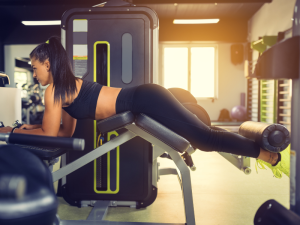
The Prone Hamstring Curl, also known as the leg curl, is an isolation exercise that specifically targets the hamstrings. This exercise can be performed using various types of equipment, including a leg curl machine, resistance bands, or stability balls, and is effective for strengthening the hamstrings while also improving knee stability.
How To Do Hamstring Curl (Using Leg Curl Machine)?
- Begin by adjusting the leg curl machine to fit your body size and selecting an appropriate weight.
- Lie face down on the machine with your knees positioned just beyond the edge of the bench and your ankles under the padded lever.
- Grasp the handles or hold onto the bench for stability.
- Engage your core and maintain a neutral spine throughout the movement.
- Flex your knees to curl the padded lever towards your glutes, squeezing your hamstrings at the top of the movement.
- Pause briefly at the top, then slowly lower the padded lever back to the starting position under control.
Execution Tips Enhanced:
- Keep your hips flat on the bench and avoid lifting them off during the exercise.
- Focus on contracting the hamstrings to curl the weight, rather than using momentum.
- Maintain a controlled tempo throughout the movement, emphasizing both the concentric (lifting) and eccentric (lowering) phases.
- Use a full range of motion while maintaining tension in the hamstrings.
Why It Works Explained:
The hamstring curl isolates and targets the hamstrings, making it an effective exercise for strengthening these muscles. Strong hamstrings are essential for various lower body movements, including walking, running, and jumping, as well as stabilizing the knee joint during activities.
By improving hamstring strength, the hamstring curl can help reduce the risk of injuries such as hamstring strains and improve overall lower body function and performance.
15. Seated Hamstring Curl

The seated hamstring curl is an isolation exercise that specifically targets the hamstrings. This exercise is typically performed using a seated leg curl machine and is effective for strengthening the hamstrings while also improving knee stability.
How To Do Seated Hamstring Curl?
- Begin by adjusting the leg curl machine to fit your body size and selecting an appropriate weight.
- Sit on the machine with your back against the backrest and your knees positioned just beyond the edge of the bench.
- Place your lower legs under the padded lever, ensuring that the pad is positioned just above your ankles.
- Grasp the handles or hold onto the bench for stability.
- Engage your core and maintain a neutral spine throughout the movement.
- Flex your knees to curl the padded lever towards your glutes, squeezing your hamstrings at the top of the movement.
- Pause briefly at the top, then slowly lower the padded lever back to the starting position under control.
Execution Tips Enhanced:
- Keep your hips flat against the bench throughout the movement to isolate the hamstrings.
- Focus on contracting the hamstrings to curl the weight, rather than using momentum.
- Control the movement both on the way up and on the way down to fully engage the hamstrings.
- Use a full range of motion while maintaining tension in the hamstrings.
Why It Works Explained:
The seated hamstring curl isolates and targets the hamstrings, making it an effective exercise for strengthening these muscles. Strong hamstrings are essential for various lower body movements, including walking, running, and jumping, as well as stabilizing the knee joint during activities.
By improving hamstring strength, the seated hamstring curl can help reduce the risk of injuries such as hamstring strains and improve overall lower body function and performance.
16. Smith Machine Romanian Deadlift
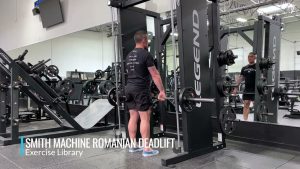
The Smith machine Romanian deadlift is a variation of the traditional Romanian deadlift performed using a Smith machine. This exercise primarily targets the hamstrings, glutes, and lower back, while also engaging the core and upper body for stability.
How To Do Smith Machine Romanian Deadlift?
- Begin by setting up a Smith machine with the barbell at hip height.
- Stand facing the barbell with your feet shoulder-width apart and your knees slightly bent.
- Grip the barbell with an overhand grip, hands slightly wider than shoulder-width apart.
- Engage your core and retract your shoulder blades to maintain a neutral spine throughout the movement.
- Keeping a slight bend in your knees, hinge at your hips and lean forward, lowering the barbell towards the floor.
- Lower the barbell until you feel a stretch in your hamstrings or until your torso is parallel to the floor, keeping your back straight.
- Keep the movement controlled and avoid rounding your back.
- Pause briefly at the bottom of the movement, then reverse the motion by driving through your heels and extending your hips to return to the starting position.
Execution Tips Enhanced:
- Keep your movements controlled and avoid using momentum to lift the weight.
- Focus on pushing your hips back as you lower the weight, emphasizing the stretch in the hamstrings.
- Maintain tension in the hamstrings throughout the movement.
- Use a weight that allows you to maintain proper form and control throughout the exercise.
Why It Works Explained:
The Smith machine Romanian deadlift targets the hamstrings, glutes, and lower back, making it an effective exercise for building strength and muscle mass in the posterior chain. The guided bar path provided by the Smith machine allows for greater stability and control during the movement, making it suitable for beginners or those with limited mobility.
Additionally, the Smith machine Romanian deadlift helps improve hip mobility and flexibility while reducing the risk of lower back injury compared to traditional deadlift variations.
17. Dumbbell Romanian Deadlift
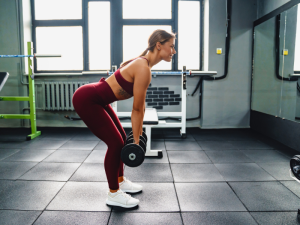
The dumbbell Romanian deadlift, also known as the dumbbell RDL, is a variation of the traditional Romanian deadlift performed using dumbbells. This exercise primarily targets the hamstrings, glutes, and lower back, while also engaging the core and upper body for stability.
How To Do Dumbbell Romanian Deadlift?
- Begin by standing with your feet hip-width apart and holding a pair of dumbbells in front of your thighs with an overhand grip.
- Engage your core and retract your shoulder blades to maintain a neutral spine throughout the movement.
- Keeping a slight bend in your knees, hinge at your hips and lean forward, lowering the dumbbells towards the floor.
- Lower the dumbbells until you feel a stretch in your hamstrings or until your torso is parallel to the floor, keeping your back straight.
- Keep the movement controlled and avoid rounding your back.
- Pause briefly at the bottom of the movement, then reverse the motion by driving through your heels and extending your hips to return to the starting position.
Execution Tips Enhanced:
- Keep your movements controlled and avoid using momentum to lift the dumbbells.
- Focus on pushing your hips back as you lower the weight, emphasizing the stretch in the hamstrings.
- Maintain tension in the hamstrings throughout the movement.
- Keep the dumbbells close to your body throughout the exercise to maintain proper form and alignment.
Why It Works Explained:
The dumbbell Romanian deadlift targets the hamstrings, glutes, and lower back, making it an effective exercise for building strength and muscle mass in the posterior chain. Using dumbbells allows for greater freedom of movement and unilateral training, helping to correct muscle imbalances between the left and right sides of the body.
Additionally, the dumbbell Romanian deadlift improves hip mobility and flexibility while also enhancing grip strength and forearm development. It’s a versatile exercise that can be performed anywhere with access to dumbbells, making it suitable for individuals of all fitness levels.
Practical Advice for Lower Body Pull Exercises: Actionable and Clear
Here’s some practical advice for incorporating Lower Body Pull Exercises into your workout routine:
- Start with Compound Movements: Begin your lower body pull workout with compound exercises such as deadlifts, Romanian deadlifts, or sumo deadlifts. These movements target multiple muscle groups simultaneously and provide a strong foundation for your workout.
- Focus on Proper Form: Prioritize proper form and technique over lifting heavy weights. Maintain a neutral spine, engage your core, and keep your movements controlled throughout each exercise to prevent injury and maximize muscle engagement.
- Gradually Increase Weight: As you become more comfortable with the exercises and your form improves, gradually increase the weight you’re lifting. Aim to challenge yourself while still maintaining proper form and control.
- Incorporate Unilateral Exercises: Include unilateral exercises such as single-leg Romanian deadlifts or Bulgarian split squats to address muscle imbalances and improve stability and coordination.
- Use a Variety of Equipment: Experiment with different equipment options such as barbells, dumbbells, resistance bands, or machines to target your muscles from various angles and intensities.
- Include Assistance Exercises: Supplement your compound movements with assistance exercises like glute bridges, cable pull-throughs, or hamstring curls to target specific muscle groups and enhance overall muscle development.
- Warm-Up Properly: Prior to your workout, perform a thorough warm-up routine that includes dynamic stretches and mobility exercises to prepare your muscles and joints for the upcoming workout.
- Progressive Overload: Incorporate progressive overload principles into your training by gradually increasing the weight, reps, or sets over time. This progressive challenge stimulates muscle growth and strength gains.
- Listen to Your Body: Pay attention to your body’s signals and adjust your workout intensity or exercises accordingly. If you experience pain or discomfort, modify the exercise or seek guidance from a fitness professional.
- Rest and Recovery: Allow adequate rest and recovery between workouts to allow your muscles to repair and grow. Aim for at least 48 hours of rest between intense lower body pull sessions to optimize recovery and prevent overtraining.
Key Takeaways and Final Thoughts on including Lower Body Pull Exercises
In conclusion, including Lower Body Pull Exercises into your workout routine offers numerous benefits for overall physical health and well-being. These exercises target major muscle groups in the posterior chain, including the hamstrings, glutes, and lower back, promoting strength, stability, and functional movement patterns.
Conventional belief often dictates the need for a multitude of exercises to target different major muscle groups. However, as evidenced here, this isn’t always true.
The above selection highlights 17 highly effective lower body pull exercises. Yet you don’t need to include all of them into your workout routine hoping develop your lower body. Instead, focusing on just three or four key movements( make sure to insert them strategically into a well-rounded workout routine) can yield remarkable muscle growth and hypertrophy.
Key Points:
- Lower body pull exercises are essential for developing the posterior chain, including muscles like the hamstrings, glutes, and lower back.
- Exercises such as deadlifts, sumo deadlifts, and Romanian deadlifts play a pivotal role in enhancing lower body strength and functionality.
- Bodyweight movements like the glute ham raise demonstrate that significant strength gains can be achieved without the use of equipment.
- Incorporating balance and unilateral exercises, such as the single-leg Romanian deadlift, can improve coordination and address muscle imbalances.
- Accessory exercises like the Nordic hamstring curls, glute bridges, cable pull throughs, and reverse hyperextensions offer targeted ways to strengthen and sculpt the lower body.
- Understanding the difference between push and pull exercises helps in designing a balanced workout routine that covers all major muscle groups.
- Leg extensions and squats are examples of push exercises, focusing on the quadriceps and the overall lower body pushing muscles, respectively.
- Hip abduction movements are categorized as pull exercises, crucial for lateral leg movements and stabilizing the hips.
- Classifying exercises correctly as push or pull can guide athletes and fitness enthusiasts in creating comprehensive training plans that promote balanced muscle development and prevent injury.
FAQs
Who should perform lower body pull exercises?
Lower body pull exercises are suitable for individuals of all fitness levels, from beginners to advanced athletes. However, proper form is crucial to prevent injury. If you’re new to exercise, consult a certified personal trainer for guidance.
What’s the difference between deadlifts and Romanian deadlifts?
Deadlifts involve lifting the weight from the ground, while RDLs start with the weight already lifted and focus on lowering it while maintaining a straight back. RDLs primarily target the hamstrings, while deadlifts work multiple muscle groups.
Should I do single-leg Romanian deadlifts if I have balance issues?
If you have significant balance issues, it’s best to build your strength and stability with regular RDLs before progressing to single-leg variations.
Are good mornings good for building a strong core?
While good mornings do engage the core muscles, they primarily target the lower back. Exercises like planks and dead bugs are more effective for core strengthening.
I don’t have access to a gym. Can I still do lower body pull exercises?
Yes! Exercises like bodyweight squats, lunges, and Nordic hamstring curls can be excellent alternatives to gym-based exercises.
Which body parts are involved in pull exercises?
In pull exercises, you engage the upper body pulling muscles, which include the back and biceps. For the lower body, pull exercises primarily target the posterior chain muscles, such as the hamstrings, glutes, and lower back, enhancing strength and stability across these areas.
Is the leg extension considered a push or pull exercise?
Leg extension is categorized as a pushing exercise. It contrasts with leg curls, which are considered pulling exercises. While leg extensions target the quadriceps at the front of the thigh, leg curls focus on strengthening the hamstrings at the back of the thigh.
Are squats classified as push or pull exercises?
Squats are considered lower-body push exercises. They engage the quads, hamstrings, calves, and glutes, emphasizing a pushing motion away from the ground. Squats are fundamental for building strength and power in the lower body, making them a staple in push workout routines.
Is hip abduction a push or pull movement?
Hip abduction is a pull movement. The hip abductors are muscles on the outer edges of your hips that facilitate pulling and lifting your legs to the side. These muscles are crucial for lateral movements, stability, and supporting everyday activities like walking and standing.
Are hip thrusts categorized as push or pull exercises?
Hip thrusts are identified as a “push” exercise. The primary action involves pushing the hips upwards, which activates the glutes and hamstrings. Despite being a push exercise, hip thrusts significantly contribute to strengthening the posterior chain.
Is hip extension considered a push or pull exercise?
Hip extension exercises are predominantly categorized as pull exercises. They involve a pulling action initiated by the hip extensors, such as the glutes and hamstrings, to extend the hip. These exercises are vital for enhancing the strength and functionality of the posterior chain muscles.

ABOUT THE AUTHOR
Follow Valen Steven for a dose of fitness enthusiasm, evidence-based advice, and a roadmap to achieving your health and wellness goals.
Subscribe to our Newsletter
Dive into a world of fitness and wellness with our exclusive newsletter! Sign up now and receive weekly power-packs of fitness wisdom

